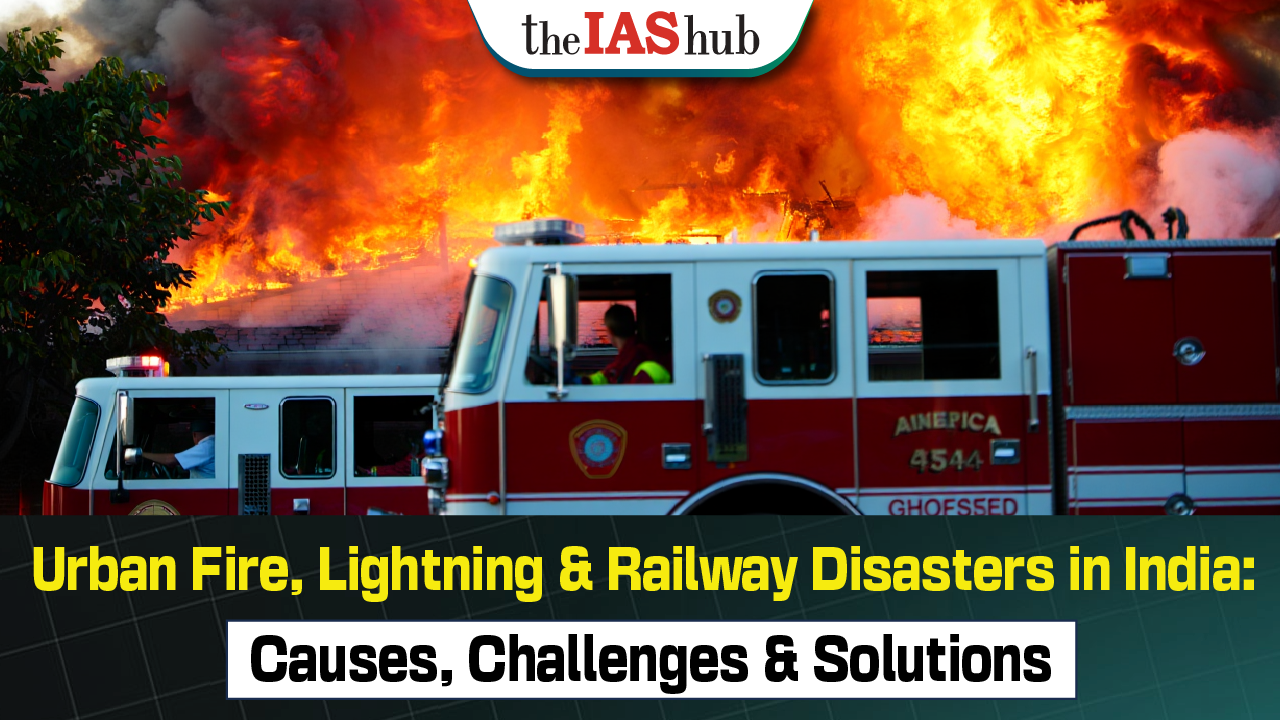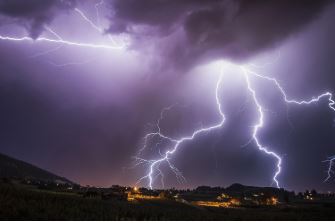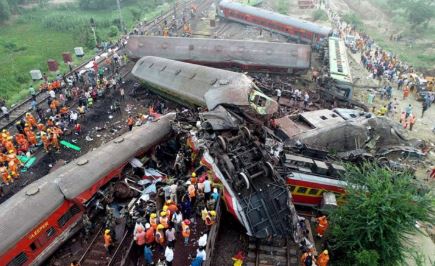The recent fire incident in Delhi is yet another case of man-made disaster that the capital has witnessed. Fire incidents in India speak volumes of how India’s urban centers have time and again failed to meet the very basic safety norms. Indian cities have seen disastrous fire incidents before such as at Uphar Cinema (1997), the Lal Kuan fire tragedy (1999), the Anand Mandi fire (2019), and Hotel fire in Karol Bagh (2019)
- India witnessed urban fire in cities like Delhi, Kamala Mills, Surat coaching centre.
- According to NCRB, 17,700 Indians die due to fire accidents.
- Maharashtra and Gujarat account for about 30% of the country's fire death.
|
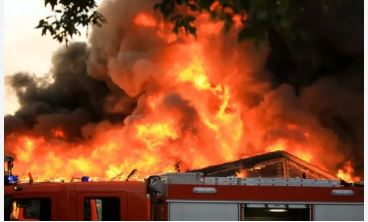
Reasons for Urban Fire
- Electrical malfunctions: Faulty wiring, overloaded circuits, and other electrical issues can cause fires in urban areas.
- Cooking accidents: Cooking equipment, such as stoves and ovens, can malfunction or be left unattended, leading to fires.
- Smoking: Carelessly discarded cigarettes and other smoking materials can start fires in urban areas.
- Arson: Deliberately set fires by individuals seeking to cause damage or harm.
- Heating equipment: Furnaces, space heaters, and other heating equipment can malfunction and cause fires.
- Chemicals and flammable materials: Improper storage or handling of chemicals and other flammable materials can lead to fires in urban areas.
- Natural disasters: Earthquakes, hurricanes, and other natural disasters can damage buildings and infrastructure, leading to fires.
Issues in Urban Fire Management
Solutions for Urban Fire Tragedies
- Regular maintenance of electrical wiring and equipment to prevent malfunctions.
- Educating people on safe cooking practices and ensuring proper functioning of cooking equipment.
- Enforcing strict laws against smoking in public areas and providing designated smoking zones.
- Increasing surveillance and monitoring to prevent arson attacks.
- Regular maintenance and inspection of heating equipment to prevent malfunctions.
- Proper storage and handling of chemicals and flammable materials, and enforcing safety regulations.
- Implementing disaster management plans and ensuring quick response in case of natural disasters.
Conclusion
Overall, prevention is key to avoiding urban fires. Educating people on fire safety, enforcing safety regulations, and regularly maintaining equipment can go a long way in preventing tragic incidents.
The Demand for Lightening to be Declared as Disaster
- Recent news reveals that several states in India have appealed for the recognition of "lightning" as a "natural disaster," due to its high casualty rate.
- Currently, disasters covered under the State Disaster Response Fund (SDRF), primarily financed by the Central Government, include cyclones, droughts, earthquakes, fires, floods, tsunamis, hailstorms, landslides, avalanches, cloudbursts, pest attacks, frost, and cold waves.
Lightening: Definition and Process
- Lightning, a natural process involving a brief, high-voltage electrical discharge between a cloud and the ground or within a cloud itself, can be lethal due to its high electric voltage and current, particularly in the case of cloud-to-ground lightning.
- Lightning is created by an electrical charge difference between the top and bottom of a cloud, leading to an immense electric current flow.
- Studies suggest a correlation between climate change and increased lightning frequency.
- A one-degree Celsius rise could result in a 12% increase in lightning strikes. A significant increase in lightning activity has been noted in the Arctic.
Lightening in India: Impact and Statistics
- India reportedly experienced approximately 18.5 million lightning strikes from April 2020 to March 2021, resulting in over 2,500 deaths annually.
- States like Odisha, Madhya Pradesh, Chhattisgarh, West Bengal, and Jharkhand are the most affected.
- As per government data, lightning strikes caused over 100,000 fatalities in India between 1967 and 2019.
Conclusion
To counter such issues of lightning, early warning systems and education on lightning safety measures are necessary, especially in rural areas. Moreover, supporting research and development projects to understand and mitigate lightning risks could be beneficial.
Provisions of Declaring a Natural Calamity as National Calamity
- Defining a Disaster: According to the Disaster Management Act, of 2005, a disaster is a grave occurrence, either natural or man-made, resulting in significant loss of life, human suffering, property damage, or environmental degradation.
- No Provision for National Calamity: The Act and the existing guidelines of the State Disaster Response Fund (SDRF)/ National Disaster Response Fund (NDRF) do not have provisions to declare a disaster as a 'National Calamity.' Despite this, there have been instances where events of severe nature, like the Gujarat earthquake in 2001 and the super cyclone in Odisha in 1999, were treated as calamities of 'unprecedented severity.'
- Calamity of Severe Nature/Rarest Severity: While there is no fixed criterion to define a 'calamity of rare severity,' the 10th Finance Commission suggested that such a classification should be adjudged on a case-by-case basis, considering the calamity's intensity, magnitude, required level of assistance, and the state's capacity to handle the crisis.
- Assistance and Benefits: When a calamity is declared of 'severe nature' or 'rarest severity,' it triggers support from the central government, including additional assistance from the NDRF, relief in loan repayments, and provisions for fresh loans on concessional terms for the affected people. Also, an Inter-ministerial group studies the damage assessment and recommends assistance from the NDRF/National Calamity Contingency Fund (NCCF).
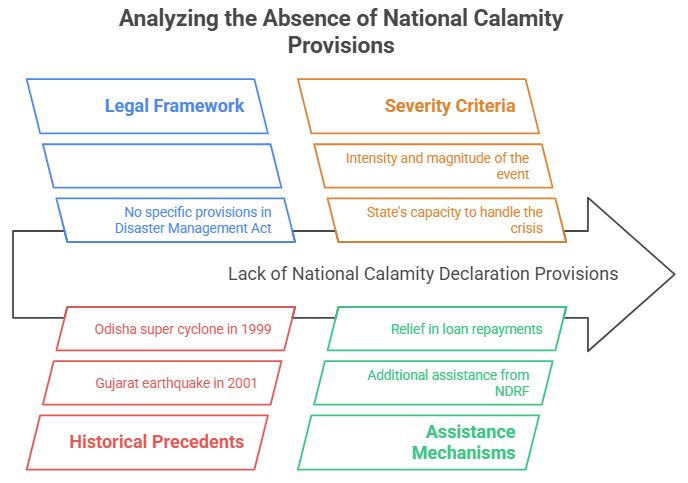
Conclusion
The effective and efficient implementation of these provisions is crucial in minimizing the impact of disasters on life, property, and the economy. Also, countries like the US have dedicated federal agencies for disaster management, and their governance frameworks could offer valuable insights to further strengthen India's disaster management capacities.
Railway Accidents and Disasters
- Indian Railways is one of the largest railway networks worldwide. Despite the reduction in accidents over the years, incidents like the Balasore Tragedy emphasize the need for better safety measures.
- Accidents are attributed to infrastructure defects, human errors, signaling failures, and Unmanned level crossings (UMLCs).
- Comparisons with foreign railway systems indicate the need for improved safety measures in India.
Reasons for Railway Accidents
- Infrastructure Defects: Aged infrastructure, lack of funds, and inefficiency contribute to accidents. Overcapacity is also a risk factor.
- Human Errors: The railway staff may make errors due to fatigue, negligence, or lack of adequate training, leading to miscommunication or overlooking safety rules.
- Signaling Failures: These can lead to dangerous situations such as trains running on the wrong track or overshooting stations.
- Unmanned Level Crossings: These pose a high risk of accidents as vehicles or pedestrians may not notice the approaching train.
Efforts by Railways to Enhance Safety
- Rashtriya Rail Sanraksha Kosh (RRSK): A safety fund established for critical safety related works.
- Technological Upgradation: Introduction of Modified Centre Buffer Couplers, Bogie Mounted Air Brake System (BMBS), and KAVACH - an Automatic Train Protection system.
- LHB Design Coaches: These coaches offer better safety features and a longer service life.
- GPS based Fog Pass Device: Helps loco pilots navigate in foggy conditions.
- Modern Track Structure: The use of Prestressed Concrete Sleeper (PSC), higher Ultimate Tensile Strength (UTS) rails and Steel Channel Sleepers on girder bridges have made tracks and bridges more durable.
- Ultrasonic Flaw Detection (USFD): This technique is used to detect and remove faulty rails.
- Mechanization of Track Maintenance: Machines are used for track maintenance activities reducing human errors.
- Interlocking System: Controls points and signals centrally, eliminating the need for manual operation.
- Elimination of Unmanned Level Crossings: Efforts are made to progressively eliminate UMLCs.
Recommendations from Various Committees
- Kakodkar Committee suggested a statutory Railway Safety Authority, adopting advanced technologies, and improving human resource management.
- Bibek Debroy Committee suggested separating the railway budget from the general budget and outsourcing non-core activities.
- Vinod Rai Committee recommended an independent Railway Safety Authority and Accident Investigation Board, creating a separate Railway Infrastructure Company, and a performance-linked incentive scheme for employees.
Way Forward
- More investment in safety-related work and employee training is needed. Level crossings need to be eliminated and advanced technologies adopted.
- A performance-linked incentive system could be introduced, and non-core work could be outsourced.
- The establishment of a statutory Railway Safety Authority and regular safety audits and inspections are required.
- Improved coordination and communication within railway operations is needed.
- A Confidential Incident Reporting and Analysis System (CIRAS) can encourage real-time reporting of deviations.
- The Indian Railways Management Service (IRMS) scheme should be reevaluated to promote a stronger commitment to safety.
